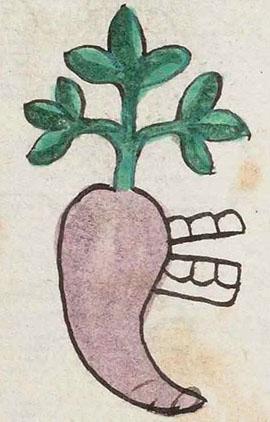Cimatlan (Mdz44r)
This compound glyph for the place name Cimatlan has two principal elements, a medicinal plant (cimapahtli), and a set of teeth (tlantli). The teeth are actually meant to provide the phonetic value for the locative suffix, -tlan. The cimapahtli is represented with emphasis on the root, which is colored lavender, and its tip turns to the viewer's right. The white teeth, with both uppers and lowers, are also on the viewer's right, in a profile view. The medicinal plant has a green leafy top component consisting of a leader and two branches. The green is two tones, light and dark.
Stephanie Wood
Michel Oudijk explains (in a presentation 4/18/2023 at the Library of Congress) that the place name Cimatlan (today spelled Zimatlan) in this part of the state of Oaxaca was misunderstood by the person glossing the glyph, who saw a camote in the root of this plant.
According to Gordon Whittaker, the full set of teeth is often meant to provide the postposition -titlan, but this is an exception, where the teeth only provide the phonetic component for the locative suffix -tlan, near.
Stephanie Wood
camotlan. puo
Camotlan, pueblo (but should read Cimatlan)
Stephanie Wood
c. 1541, but by 1553 at the latest
Stephanie Wood
sweet potatoes, camotes, plants, plantas, medicinales, hierbales, hierbas, remedies, remedios, pahtli, patli, nombres de lugares

cima(pahtli), sweet potato, https://nahuatl.wired-humanities.org/content/cimapahtli
tlan(tli), tooth/teeth, https://nahuatl.wired-humanities.org/content/tlantli
-tlan (locative suffix), by, near, among, https://nahuatl.wired-humanities.org/content/tlan
"Sweet Potato Place" (Karttunen sees the locative suffix as -tlan not -tlah, and therefore she does not embrace the "abundance" element that would go with the second suffix.) [Frances Karttunen, unpublished manuscript, used here with her permission.]
"Place of Many Sweet Potatoes" (Berdan and Anawalt, 1992, vol. 1, p. 176)
Cerca de los Raíces o Tubérculos Comestibles
Stephanie Wood
Codex Mendoza, folio 44 recto, https://digital.bodleian.ox.ac.uk/objects/2fea788e-2aa2-4f08-b6d9-648c00..., image 98 of 188.
The Bodleian Libraries, University of Oxford, hold the original manuscript, the MS. Arch. Selden. A. 1. This image is published here under the UK Creative Commons, “Attribution-NonCommercial-ShareAlike 3.0 License” (CC-BY-NC-SA 3.0).



